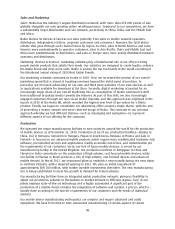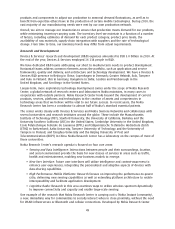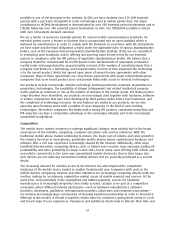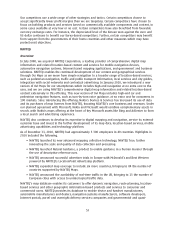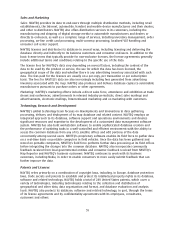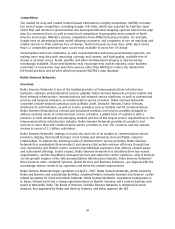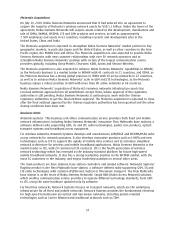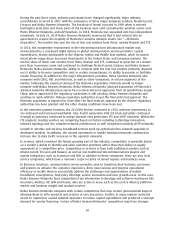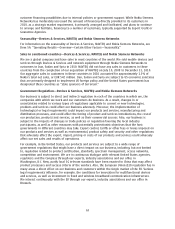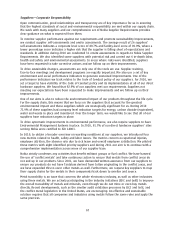Nokia 2010 Annual Report Download - page 58
Download and view the complete annual report
Please find page 58 of the 2010 Nokia annual report below. You can navigate through the pages in the report by either clicking on the pages listed below, or by using the keyword search tool below to find specific information within the annual report.Motorola Acquisition
On July 19, 2010, Nokia Siemens Networks announced that it had entered into an agreement to
acquire the majority of Motorola’s wireless network assets for USD 1.2 billion. Under the terms of the
agreement, Nokia Siemens Networks will acquire assets related to the development, manufacture and
sale of CDMA, WiMAX, WCDMA, LTE and GSM products and services, as well as approximately
7 500 employees and assets in 63 countries, including research and development sites in the
United States, China and India.
The Motorola acquisition is expected to strengthen Nokia Siemens Networks’ market position in key
geographic markets, in particular Japan and the United States, as well as other countries in the Asia
Pacific region, the Middle East and Africa. The Motorola acquisition is also expected to provide Nokia
Siemens Networks with new customer relationships with over 50 network operators and to
strengthen Nokia Siemens Networks’ position with certain of the largest communication service
providers globally, including China Mobile, Clearwire, KDDI, Sprint and Verizon Wireless.
The Motorola acquisition is also expected to enhance Nokia Siemens Networks’ capabilities in WiMAX,
as the Motorola business is a market leader in WiMAX with 41 contracts in 21 countries, and CDMA, as
the Motorola business has a strong global presence in CDMA with 30 active networks in 22 countries,
as well as to enhance Nokia Siemens Networks’ scale in GSM and LTE technologies, as the Motorola
business enjoys a robust position in GSM with more than 80 active networks in 66 countries.
Nokia Siemens Networks’ acquisition of Motorola’s wireless networks infrastructure assets has
received antitrust approvals from all jurisdictions except China, where approval of the regulatory
authorities is still pending. Nokia Siemens Networks is continuing to work with the Chinese
regulatory authorities to get the final antitrust approval. The Motorola acquisition is expected to close
after the final antitrust approval by the Chinese regulatory authorities has been granted and the other
closing conditions have been met.
Business Units
Network Systems:
This business unit offers communication service providers both fixed and mobile
network infrastructure, including Nokia Siemens Networks’ innovative Flexi Multiradio base stations, a
software defined radio supporting GSM, 3G and LTE radio technologies, packet core products, optical
transport systems and broadband access equipment.
For wireless networks, Network Systems develops and manufactures GSM/EDGE and WCDMA/HSPA radio
access networks for network operators. It also develops innovative products such as IHSPA and new
technologies such as LTE to support the uptake of mobile data services and to introduce simplified
network architecture for wireless and mobile broadband applications. Nokia Siemens Networks is the
market leader in LTE, with 20 commercial LTE contracts. LTE is the fourth generation of wireless
network technology which has emerged as the industry standard platform for future highspeed
mobile broadband networks. It also has a strong leadership position in the WCDMA market, with the
most 3G customers in the industry, and enjoys leadership positions in several other areas.
The main products are base stations, base station controllers and related software. Networks Systems’
flagship product is the Flexi Multiradio base station, a software defined radio supporting GSM, 3G and
LTE radio technologies with common IP/Ethernet, Optical or Microwave transport. The Flexi Multiradio
base station is at the heart of Nokia Siemens Networks’ Single RAN (Radio Access Network) solution,
which enables communication service providers to operate different technology standards, from GSM
to LTE, using the same hardware updated only by software.
For fixed line networks, Network Systems focuses on transport networks, which are the underlying
infrastructure for all fixed and mobile networks. Network Systems provides the fundamental elements
for highspeed transmission via optical and microwave networks, including packetoriented
technologies such as Carrier Ethernet and traditional protocols such as TDM.
57



